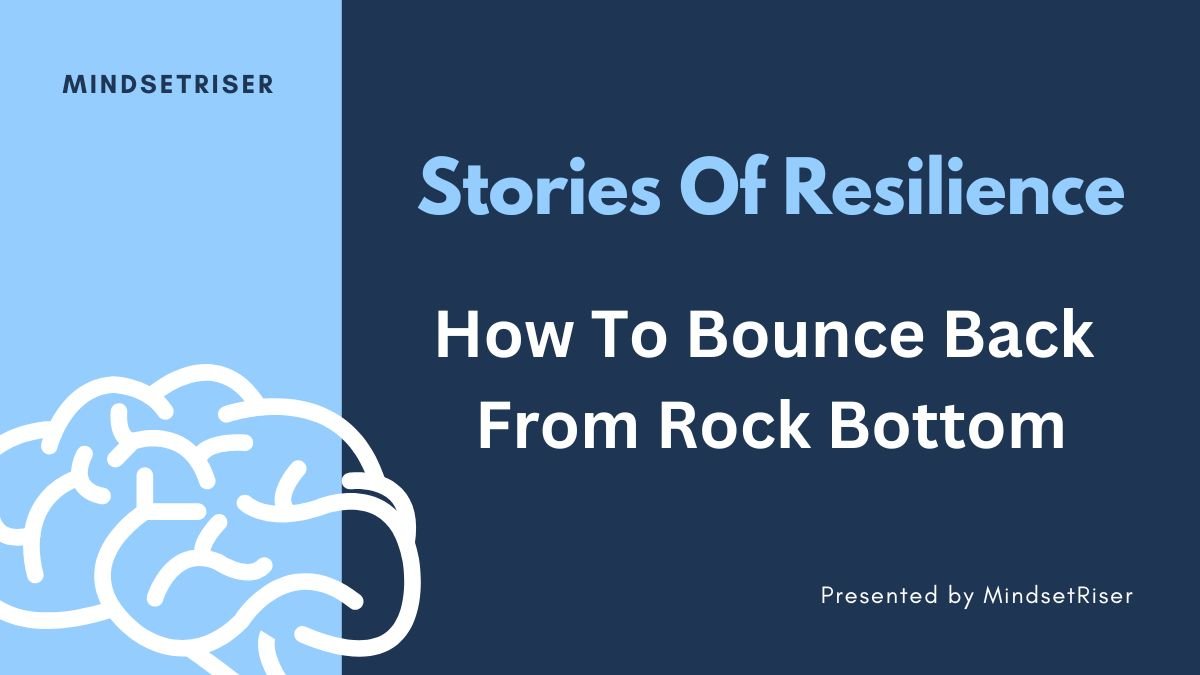How to Bounce Back from Rock Bottom (True Stories of Resilience)
How to Bounce Back from Rock Bottom (True Stories)
Hitting rock bottom is a painful and often humbling experience. Whether it’s the loss of a job, a personal tragedy, financial struggles, or the end of a relationship, everyone faces moments in life where things seem impossible to overcome. But the good news is that rock bottom doesn’t have to be the end. It can be a turning point, a moment of rebirth where you discover your inner strength and resilience.
In this article, we will explore how to bounce back from rock bottom and find success on the other side. We’ll also look at true stories of people who have faced immense challenges and emerged stronger, showing that it is possible to rise from the deepest lows.
What Does “Rock Bottom” Really Mean?
“Rock bottom” is often used to describe a moment of personal crisis—where everything seems to be falling apart. It’s a feeling of having lost control, having no way to go but up. But it’s important to remember that rock bottom isn’t permanent; it’s just a point in time.
Common Experiences of Hitting Rock Bottom:
- Financial Crisis: Losing a job, facing bankruptcy, or accumulating debt.
- Personal Loss: The death of a loved one or the end of a significant relationship.
- Health Issues: A serious illness or injury that alters life dramatically.
- Emotional Struggles: Experiencing depression, anxiety, or feelings of hopelessness.
- Failure: Losing a business or failing at something important.
The key to bouncing back is understanding that you are not defined by your lowest point. Everyone goes through struggles, and while it can be incredibly painful, these moments can also be catalysts for change.
The Psychology Behind Bouncing Back
The ability to recover from rock bottom is known as resilience. Resilience is not a trait that some people are born with and others are not—it is something that can be developed over time through mindset and action.
Factors That Influence Resilience:
- Optimism: Seeing the world in a positive light can help you believe that things will improve.
- Self-Worth: Knowing your value and believing in your abilities can drive you to keep pushing forward.
- Social Support: Having a network of supportive friends, family, or mentors can be crucial when you’re facing tough times.
- Adaptability: The ability to adjust and adapt to changing circumstances is key to overcoming adversity.
- Purpose: Having a strong sense of purpose and a reason to keep going can make all the difference in the world.
To bounce back, take action toward rebuilding your life, and cultivate a mindset that focuses on progress rather than perfection. Your journey back from rock bottom may not be smooth, but every step forward is a step toward healing and renewal.
How to Bounce Back from Rock Bottom
Here are the steps to help you navigate the journey of bouncing back:
1. Acknowledge Your Pain and Accept Your Situation
The first step in bouncing back is to acknowledge what has happened and accept that you’re in a difficult situation. Denying your pain or pretending that everything is fine when it’s not will only prolong your recovery.
- Allow yourself to feel: It’s okay to be upset, frustrated, or angry. These emotions are part of the healing process.
- Understand your reality: Take a moment to assess where you are, what happened, and why it’s affecting you. Write it down if it helps.
By acknowledging your pain, you create the space to heal and rebuild.
2. Focus on What You Can Control
When life feels out of control, it’s easy to feel helpless. But there are always aspects of your life that you can control, no matter how small they seem. Focusing on the things you can control empowers you to take back your sense of agency.
- Start small: Focus on daily habits that help you regain stability, such as a morning routine, exercise, or eating well.
- Set small, manageable goals: Whether it’s applying for one job a day, reading one chapter of a book, or going for a walk, take action in a way that moves you forward.
By controlling what you can, you take the first step toward rebuilding your life.
3. Seek Support and Build Your Network
The road to recovery can feel long and lonely, but support from others can help lighten the load. Reaching out to friends, family, or a therapist can provide you with guidance and perspective.
- Talk to someone: Sharing your feelings with someone you trust can be incredibly cathartic.
- Find a mentor: Seek out someone who has been through adversity and can offer advice on how to overcome challenges.
- Join a community: Whether it’s a support group, an online community, or a fitness group, connecting with others can help you feel less isolated.
Support systems are a key factor in building resilience and moving forward.
4. Rebuild Your Mindset and Focus on the Positive
Mindset is everything. After hitting rock bottom, it’s easy to feel like you’ll never recover. However, your thoughts have a powerful influence on your actions and your future.
- Practice gratitude: Write down three things you’re grateful for every day. Even when life feels hard, this practice can help shift your mindset.
- Embrace the power of positive thinking: Instead of focusing on what went wrong, think about what you’ve learned from the experience and how it can help you grow.
- Visualize your success: Take a moment each day to visualize where you want to be and the steps you need to take to get there.
A positive mindset helps you stay hopeful and motivated as you begin to rebuild.
5. Take Care of Your Physical and Mental Health
Your body and mind are deeply connected. Physical well-being has a profound impact on your mental health. If you’ve been through a tough time, taking care of your health is an essential part of bouncing back.
- Exercise regularly: Physical activity boosts endorphins and helps reduce stress and anxiety.
- Eat nourishing foods: Fuel your body with wholesome food that supports your energy levels.
- Sleep well: Rest is essential for mental clarity and emotional stability.
- Practice mindfulness or meditation: These practices can help reduce anxiety, promote mental calm, and enhance your resilience.
Taking care of your body will support your mind and make it easier to navigate difficult times.
True Stories of Bouncing Back from Rock Bottom
1. J.K. Rowling: Overcoming Rejection and Poverty
Before becoming a globally renowned author, J.K. Rowling faced multiple rejections from publishers and lived in near poverty. She was a single mother, struggling with depression and uncertainty about her future. However, she refused to give up on her dreams of becoming a writer. Rowling persevered through rejection after rejection, and eventually, Harry Potter and the Sorcerer’s Stone was published.
Her story is a powerful example of how persistence and belief in yourself can turn rock bottom into the foundation for extraordinary success.
2. Steve Jobs: Returning to Apple After Being Fired
Steve Jobs was famously fired from Apple, the company he founded. After his dismissal, Jobs went through a period of self-reflection and struggle. But instead of giving up, he continued his entrepreneurial journey, founding NeXT and acquiring Pixar, which ultimately led to his return to Apple. Under his leadership, Apple went on to revolutionize the tech industry with products like the iPhone and iPad.
Jobs’ comeback is an example of how failure can be a stepping stone to even greater achievements.
3. Elon Musk: From Failure to Space Exploration
Elon Musk is no stranger to rock bottom moments. In the early days of SpaceX, the company was on the brink of collapse. Musk invested his last dollars into the business, and if the next launch failed, he would have lost everything. However, Musk pushed through, and SpaceX became the first private company to send astronauts into space. He also achieved success with Tesla, despite facing significant challenges.
Musk’s story shows that risk-taking and persistence can lead to groundbreaking success.
Final Thoughts: Embrace the Journey of Resilience
Bouncing back from rock bottom isn’t easy, but it’s possible. The journey to recovery is filled with struggles, setbacks, and growth. What matters most is how you choose to respond. With the right mindset, support, and action, you can turn your lowest moments into the foundation for a new chapter of success.
What You Can Do Now:
- Accept where you are and start with small, manageable steps toward recovery.
- Reach out for support and connect with people who can help guide you.
- Focus on your health, both physical and mental.
- Embrace challenges as opportunities to grow stronger and more resilient.
Remember: Rock bottom isn’t the end—it’s the beginning of your comeback story.

